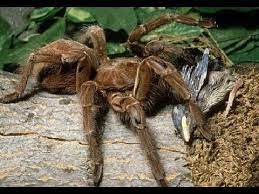In the intricate tapestry of the natural world, the Goliath birdeater spider (Theraphosa blondi) stands as an astonishing creature that both fascinates and sends shivers down the spine. With its massive size and unique behaviors, this spider has garnered attention from arachnid enthusiasts and curious minds alike. In this article, we delve into 36 captivating facts about the Goliath birdeater, shedding light on its remarkable characteristics and intriguing habits.

1. Gigantic Size: The Goliath birdeater holds the title for the world’s largest spider by mass, boasting a leg span of up to 12 inches.
2. Misleading Name: Despite its name, this spider rarely preys on birds; its diet mainly consists of insects and small rodents.
3. Territorial Nature: Goliath birdeaters are solitary creatures, occupying burrows they create in the rainforests of South America.
4. Fangs of Power: Equipped with massive fangs, these spiders deliver venomous bites that aid in subduing their prey.
5. Nocturnal Habits: Active primarily during the night, Goliath birdeaters use their keen senses to navigate and locate food.
6. Abdomen Sounds: When threatened, these spiders can rub their abdomen against their bristles, producing a hissing sound as a defense mechanism.
7. Gentle Giants: Despite their imposing size and appearance, Goliath birdeaters are relatively docile and rarely pose a threat to humans.
8. Life Expectancy: In the wild, these spiders can live for up to 15 years, making them relatively long-lived for arachnids.
9. Molting Marvel: As with all arachnids, Goliath birdeaters must shed their exoskeleton periodically to grow. Molting can occur several times a year in juveniles.
10. Silk Mastery: Goliath birdeaters use silk for constructing burrows, creating egg sacs, and lining their retreats.
11. Venom Impact: While their venom is not typically dangerous to humans, a Goliath birdeater’s bite can cause localized pain and swelling.
12. Unpredictable Behavior: When threatened, these spiders might resort to bluffing, rearing up on their hind legs to appear larger and more intimidating.
13. Efficient Predators: Goliath birdeaters employ sit-and-wait tactics, ambushing unsuspecting prey that ventures too close.
14. Hairy Defense: Their bristly hairs serve as a form of protection, deterring potential predators by causing irritation.
15. Maternal Care: Female Goliath birdeaters exhibit maternal behaviors, guarding and tending to their egg sacs until the spiderlings hatch.
16. Selective Diet: Despite their opportunistic feeding habits, these spiders show preferences for specific types of prey.
17. Rainforest Dwellers: Native to the rainforests of South America, Goliath birdeaters thrive in humid and tropical environments.
18. Slow Metabolism: Goliath birdeaters have a relatively low metabolic rate, allowing them to survive periods of scarcity.
19. Complex Mating Rituals: Courtship in Goliath birdeaters involves intricate behaviors, including drumming and vibrations.
20. Communication through Vibrations: These spiders use vibrations for communication, signaling their presence to potential mates or deterring rivals.
21. Popularity in the Trade: Due to their awe-inspiring size and unique attributes, Goliath birdeaters are sought after by exotic pet enthusiasts.
22. Ethical Considerations: Captive breeding programs aim to reduce the demand for wild-caught Goliath birdeaters in the pet trade.
23. Sensory Sensitivity: Goliath birdeaters possess sensitive hairs on their legs that help them detect vibrations in their environment.
24. Myth and Reality: Legends about the Goliath birdeater’s ability to kill birds have contributed to its intimidating reputation.
25. Role in Ecosystems: These spiders play a role in controlling insect populations, contributing to ecosystem balance.
26. Conservation Concerns: Habitat loss threatens Goliath birdeater populations, as rainforests are being cleared for development.
27. Natural Predators: Despite their size, Goliath birdeaters have predators, including larger spiders and certain reptiles.
28. Cultural Significance: In some indigenous cultures, Goliath birdeaters hold symbolic meaning and are used in rituals.
29. Medicinal Potential: Some research suggests that compounds found in Goliath birdeater venom could have medical applications.
30. Ecological Engineers: Their burrowing activities can influence soil structure and contribute to nutrient cycling.
31. Research Exploration: Scientists study Goliath birdeaters to uncover insights into their behavior, physiology, and evolutionary adaptations.
32. Nighttime Wonders: Observing Goliath birdeaters in their natural habitat at night reveals a unique perspective on their behaviors.
33. Arboreal Adaptations: Despite their large size, Goliath birdeaters are skilled climbers, capable of ascending trees and plants.
34. Webless Hunters: These spiders do not construct elaborate webs for catching prey; instead, they rely on ambush tactics.
35. Intriguing Diversity: The Goliath birdeater belongs to the Theraphosidae family, which encompasses a diverse array of tarantula species.
36. Evolving Understanding: Ongoing research into Goliath birdeaters continues to unravel mysteries about their biology and significance in ecosystems.



















Add Comment